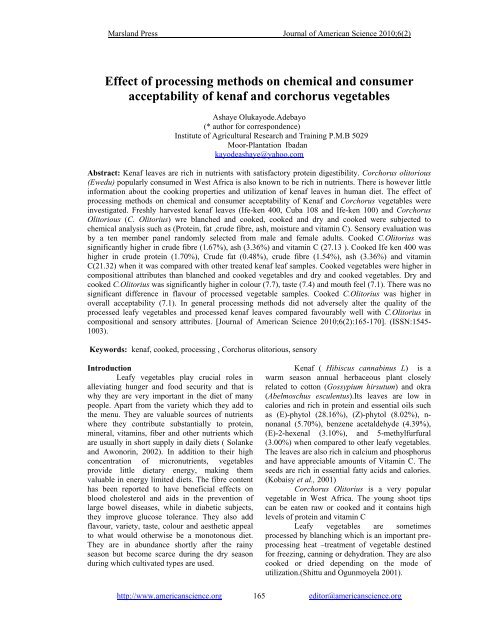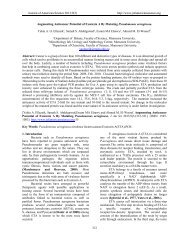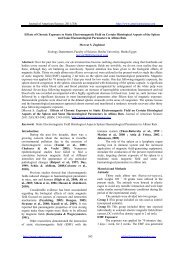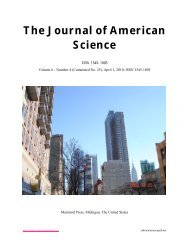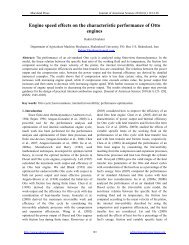Effect of processing methods on chemical and consumer
Effect of processing methods on chemical and consumer
Effect of processing methods on chemical and consumer
Create successful ePaper yourself
Turn your PDF publications into a flip-book with our unique Google optimized e-Paper software.
Marsl<strong>and</strong> Press Journal <str<strong>on</strong>g>of</str<strong>on</strong>g> American Science 2010;6(2)<br />
<str<strong>on</strong>g>Effect</str<strong>on</strong>g> <str<strong>on</strong>g>of</str<strong>on</strong>g> <str<strong>on</strong>g>processing</str<strong>on</strong>g> <str<strong>on</strong>g>methods</str<strong>on</strong>g> <strong>on</strong> <strong>chemical</strong> <strong>and</strong> c<strong>on</strong>sumer<br />
acceptability <str<strong>on</strong>g>of</str<strong>on</strong>g> kenaf <strong>and</strong> corchorus vegetables<br />
Ashaye Olukayode.Adebayo<br />
(* author for corresp<strong>on</strong>dence)<br />
Institute <str<strong>on</strong>g>of</str<strong>on</strong>g> Agricultural Research <strong>and</strong> Training P.M.B 5029<br />
Moor-Plantati<strong>on</strong> Ibadan<br />
kayodeashaye@yahoo.com<br />
Abstract: Kenaf leaves are rich in nutrients with satisfactory protein digestibility. Corchorus olitorious<br />
(Ewedu) popularly c<strong>on</strong>sumed in West Africa is also known to be rich in nutrients. There is however little<br />
informati<strong>on</strong> about the cooking properties <strong>and</strong> utilizati<strong>on</strong> <str<strong>on</strong>g>of</str<strong>on</strong>g> kenaf leaves in human diet. The effect <str<strong>on</strong>g>of</str<strong>on</strong>g><br />
<str<strong>on</strong>g>processing</str<strong>on</strong>g> <str<strong>on</strong>g>methods</str<strong>on</strong>g> <strong>on</strong> <strong>chemical</strong> <strong>and</strong> c<strong>on</strong>sumer acceptability <str<strong>on</strong>g>of</str<strong>on</strong>g> Kenaf <strong>and</strong> Corchorus vegetables were<br />
investigated. Freshly harvested kenaf leaves (Ife-ken 400, Cuba 108 <strong>and</strong> Ife-ken 100) <strong>and</strong> Corchorus<br />
Olitorious (C. Olitorius) wre blanched <strong>and</strong> cooked, cooked <strong>and</strong> dry <strong>and</strong> cooked were subjected to<br />
<strong>chemical</strong> analysis such as (Protein, fat ,crude fibre, ash, moisture <strong>and</strong> vitamin C). Sensory evaluati<strong>on</strong> was<br />
by a ten member panel r<strong>and</strong>omly selected from male <strong>and</strong> female adults. Cooked C.Olitorius was<br />
significantly higher in crude fibre (1.67%), ash (3.36%) <strong>and</strong> vitamin C (27.13 ). Cooked Ife ken 400 was<br />
higher in crude protein (1.70%), Crude fat (0.48%), crude fibre (1.54%), ash (3.36%) <strong>and</strong> vitamin<br />
C(21.32) when it was compared with other treated kenaf leaf samples. Cooked vegetables were higher in<br />
compositi<strong>on</strong>al attributes than blanched <strong>and</strong> cooked vegetables <strong>and</strong> dry <strong>and</strong> cooked vegetables. Dry <strong>and</strong><br />
cooked C.Olitorius was significantly higher in colour (7.7), taste (7.4) <strong>and</strong> mouth feel (7.1). There was no<br />
significant difference in flavour <str<strong>on</strong>g>of</str<strong>on</strong>g> processed vegetable samples. Cooked C.Olitorius was higher in<br />
overall acceptability (7.1). In general <str<strong>on</strong>g>processing</str<strong>on</strong>g> <str<strong>on</strong>g>methods</str<strong>on</strong>g> did not adversely alter the quality <str<strong>on</strong>g>of</str<strong>on</strong>g> the<br />
processed leafy vegetables <strong>and</strong> processed kenaf leaves compared favourably well with C.Olitorius in<br />
compositi<strong>on</strong>al <strong>and</strong> sensory attributes. [Journal <str<strong>on</strong>g>of</str<strong>on</strong>g> American Science 2010;6(2):165-170]. (ISSN:1545-<br />
1003).<br />
Keywords: kenaf, cooked, <str<strong>on</strong>g>processing</str<strong>on</strong>g> , Corchorus olitorious, sensory<br />
Introducti<strong>on</strong><br />
Leafy vegetables play crucial roles in<br />
alleviating hunger <strong>and</strong> food security <strong>and</strong> that is<br />
why they are very important in the diet <str<strong>on</strong>g>of</str<strong>on</strong>g> many<br />
people. Apart from the variety which they add to<br />
the menu. They are valuable sources <str<strong>on</strong>g>of</str<strong>on</strong>g> nutrients<br />
where they c<strong>on</strong>tribute substantially to protein,<br />
mineral, vitamins, fiber <strong>and</strong> other nutrients which<br />
are usually in short supply in daily diets ( Solanke<br />
<strong>and</strong> Aw<strong>on</strong>orin, 2002). In additi<strong>on</strong> to their high<br />
c<strong>on</strong>centrati<strong>on</strong> <str<strong>on</strong>g>of</str<strong>on</strong>g> micr<strong>on</strong>utrients, vegetables<br />
provide little dietary energy, making them<br />
valuable in energy limited diets. The fibre c<strong>on</strong>tent<br />
has been reported to have beneficial effects <strong>on</strong><br />
blood cholesterol <strong>and</strong> aids in the preventi<strong>on</strong> <str<strong>on</strong>g>of</str<strong>on</strong>g><br />
large bowel diseases, while in diabetic subjects,<br />
they improve glucose tolerance. They also add<br />
flavour, variety, taste, colour <strong>and</strong> aesthetic appeal<br />
to what would otherwise be a m<strong>on</strong>ot<strong>on</strong>ous diet.<br />
They are in abundance shortly after the rainy<br />
seas<strong>on</strong> but become scarce during the dry seas<strong>on</strong><br />
during which cultivated types are used.<br />
Kenaf ( Hibiscus cannabinus L) is a<br />
warm seas<strong>on</strong> annual herbaceous plant closely<br />
related to cott<strong>on</strong> (Gossypium hirsutum) <strong>and</strong> okra<br />
(Abelmoschus esculentus).Its leaves are low in<br />
calories <strong>and</strong> rich in protein <strong>and</strong> essential oils such<br />
as (E)-phytol (28.16%), (Z)-phytol (8.02%), nn<strong>on</strong>anal<br />
(5.70%), benzene acetaldehyde (4.39%),<br />
(E)-2-hexenal (3.10%), <strong>and</strong> 5-methylfurfural<br />
(3.00%) when compared to other leafy vegetables.<br />
The leaves are also rich in calcium <strong>and</strong> phosphorus<br />
<strong>and</strong> have appreciable amounts <str<strong>on</strong>g>of</str<strong>on</strong>g> Vitamin C. The<br />
seeds are rich in essential fatty acids <strong>and</strong> calories.<br />
(Kobaisy et al., 2001)<br />
Corchorus Olitorius is a very popular<br />
vegetable in West Africa. The young shoot tips<br />
can be eaten raw or cooked <strong>and</strong> it c<strong>on</strong>tains high<br />
levels <str<strong>on</strong>g>of</str<strong>on</strong>g> protein <strong>and</strong> vitamin C<br />
Leafy vegetables are sometimes<br />
processed by blanching which is an important pre<str<strong>on</strong>g>processing</str<strong>on</strong>g><br />
heat –treatment <str<strong>on</strong>g>of</str<strong>on</strong>g> vegetable destined<br />
for freezing, canning or dehydrati<strong>on</strong>. They are also<br />
cooked or dried depending <strong>on</strong> the mode <str<strong>on</strong>g>of</str<strong>on</strong>g><br />
utilizati<strong>on</strong>.(Shittu <strong>and</strong> Ogunmoyela 2001).<br />
http://www.americanscience.org 165<br />
editor@americanscience.org
<str<strong>on</strong>g>Effect</str<strong>on</strong>g> <str<strong>on</strong>g>of</str<strong>on</strong>g> <str<strong>on</strong>g>processing</str<strong>on</strong>g> <str<strong>on</strong>g>methods</str<strong>on</strong>g> <strong>on</strong> <strong>chemical</strong> <strong>and</strong> c<strong>on</strong>sumer acceptability <str<strong>on</strong>g>of</str<strong>on</strong>g> kenaf <strong>and</strong> corchorus vegetables<br />
Ashaye O.A<br />
There is however little informati<strong>on</strong> about<br />
the cooking properties <strong>and</strong> utilizati<strong>on</strong> <str<strong>on</strong>g>of</str<strong>on</strong>g> kenaf<br />
leaves in human diet. Therefore, the need for detail<br />
study <strong>on</strong> the c<strong>on</strong>tributi<strong>on</strong> <strong>and</strong> suitability <str<strong>on</strong>g>of</str<strong>on</strong>g> kenaf<br />
leaf to human diet.<br />
This work is therefore aimed at<br />
evaluating the effect <str<strong>on</strong>g>of</str<strong>on</strong>g> <str<strong>on</strong>g>processing</str<strong>on</strong>g> <str<strong>on</strong>g>methods</str<strong>on</strong>g> <strong>on</strong><br />
<strong>chemical</strong> compositi<strong>on</strong> <strong>and</strong> c<strong>on</strong>sumer acceptability<br />
<str<strong>on</strong>g>of</str<strong>on</strong>g> new <strong>and</strong> exotic varieties <str<strong>on</strong>g>of</str<strong>on</strong>g> kenaf <strong>and</strong> corchorus<br />
leaves.<br />
Materials <strong>and</strong> Methods<br />
Raw materials<br />
Freshly harvested kenaf leaves (Ife ken 400,<br />
cuba 108 <strong>and</strong> Ife ken 100 ) <strong>and</strong> corchorus leaves<br />
were obtained from the experimental farm <str<strong>on</strong>g>of</str<strong>on</strong>g> the<br />
Institute <str<strong>on</strong>g>of</str<strong>on</strong>g> Agricultural Research <strong>and</strong> Training (I.<br />
A. R. & T.), Moor Plantati<strong>on</strong>, Ibadan Nigeria. The<br />
fresh samples were blanched <strong>and</strong> cooked, dry <strong>and</strong><br />
cooked <strong>and</strong> cooked.<br />
Blanching <strong>and</strong> cooking process<br />
The freshly harvested vegetable leaves<br />
(100gm) were thoroughly cleaned in water to<br />
removed extraneous matter before soaking in<br />
200mls <str<strong>on</strong>g>of</str<strong>on</strong>g> hot water for 30 sec<strong>on</strong>ds after which<br />
they chopped <strong>and</strong> cooked for 10minutes. A pinch<br />
<str<strong>on</strong>g>of</str<strong>on</strong>g> salt was added to taste<br />
Drying <strong>and</strong> cooking process<br />
The freshly harvested vegetable leaves<br />
(100gm) were thoroughly cleaned in water to<br />
removed extraneous matter. They were then<br />
chopped <strong>and</strong> dried for 24hours at 55 O C before<br />
cooking in water for 10mins. A pinch <str<strong>on</strong>g>of</str<strong>on</strong>g> salt was<br />
added to taste<br />
Cooking process<br />
The freshly harvested vegetable<br />
leaves(100gm) were thoroughly cleaned in water<br />
to removed extraneous matter. They were then<br />
chopped before cooking in water for 10mins. A<br />
pinch <str<strong>on</strong>g>of</str<strong>on</strong>g> salt was added to taste<br />
Chemical analysis<br />
Determinati<strong>on</strong> <str<strong>on</strong>g>of</str<strong>on</strong>g> Crude Protein<br />
The micro-Kjeldahl method for protein<br />
determinati<strong>on</strong> is employed for protein<br />
determinati<strong>on</strong>. This is based <strong>on</strong> three principles:<br />
Digesti<strong>on</strong>: RNH2 + 2H2SO4 (NH4)2 + SO4 +<br />
CO2 + H2O<br />
Distillati<strong>on</strong>: (NH4)2 SO4 + 2NaOH (NH3 +<br />
H2O + Na2SO4<br />
Absorpti<strong>on</strong>: 3NH3 + H3BO3 (NH4)3 BO3<br />
Titrati<strong>on</strong>: (NH4)3 BO3 + HCl H3BO3 +<br />
3NH4Cl<br />
166<br />
Procedure<br />
The sample (0.5g) was weighed into the<br />
micro-Kjeldahl flask. To this were added 1<br />
Kjeldahl catalyst tablet <strong>and</strong> 10ml <str<strong>on</strong>g>of</str<strong>on</strong>g> c<strong>on</strong>c. H2SO4.<br />
These were set in the appropriate hole <str<strong>on</strong>g>of</str<strong>on</strong>g> the<br />
digesti<strong>on</strong> block heaters in a fume cupboard. The<br />
digesti<strong>on</strong> was left <strong>on</strong> for 4 hours after which a<br />
clear colourless soluti<strong>on</strong> was left in the tube. The<br />
digest was carefully transferred into 100ml<br />
volumetric flask, thoroughly rinsing the digesti<strong>on</strong><br />
tube with distilled water <strong>and</strong> the volume <str<strong>on</strong>g>of</str<strong>on</strong>g> the<br />
flask made up to the mark with distilled water. 5ml<br />
porti<strong>on</strong> <str<strong>on</strong>g>of</str<strong>on</strong>g> the digest was then pipetted to Kjeldahl<br />
apparatus <strong>and</strong> 5ml <str<strong>on</strong>g>of</str<strong>on</strong>g> 40% ( w /v) NaOH added.<br />
The mixture was then steam distilled <strong>and</strong><br />
the liberated amm<strong>on</strong>ia collected into a 50ml<br />
c<strong>on</strong>ical flask c<strong>on</strong>taining 10ml <str<strong>on</strong>g>of</str<strong>on</strong>g> 2% boric acid<br />
plus mixed indicator soluti<strong>on</strong>. The green colour<br />
lsoluti<strong>on</strong> was then titrated against 0.01 NHCl<br />
soluti<strong>on</strong>. At the end point, the green colour turns to<br />
wine colour, which indicates that, all the nitrogen<br />
trapped as amm<strong>on</strong>ium borate have been removed<br />
as amm<strong>on</strong>ium chloride. The percentage nitrogen<br />
was calculated by using the formula:<br />
% N = Titre value x atomic mass <str<strong>on</strong>g>of</str<strong>on</strong>g><br />
nitrogen x normality <str<strong>on</strong>g>of</str<strong>on</strong>g> HCl used x 4<br />
The crude protein is determined by<br />
multiplying percentage nitrogen by a c<strong>on</strong>stant<br />
factor <str<strong>on</strong>g>of</str<strong>on</strong>g> 6.25 (AOAC, 1990).<br />
Crude Fat Determinati<strong>on</strong><br />
The sample (1g) was weighed into fat<br />
free extracti<strong>on</strong> thimble <strong>and</strong> plug lightly with cott<strong>on</strong><br />
wool. The thimble was placed in the extractor <strong>and</strong><br />
fitted up with reflux c<strong>on</strong>denser <strong>and</strong> a 250ml<br />
soxhlet flask which has been previously dried in<br />
the oven, cooled in the dessicator <strong>and</strong> weighed.<br />
The soxhlet flask is then filled to ¾ <str<strong>on</strong>g>of</str<strong>on</strong>g> it volume<br />
with petroleum either (b.pt. 40 – 60°C) <strong>and</strong> the<br />
soxhlet flask extractor plus c<strong>on</strong>denser set was<br />
placed <strong>on</strong> the heater. The heater was put <strong>on</strong> for six<br />
hours with c<strong>on</strong>stant running water from the tap for<br />
c<strong>on</strong>densati<strong>on</strong> <str<strong>on</strong>g>of</str<strong>on</strong>g> ether vapour. The set is c<strong>on</strong>stantly<br />
watched for ether leaks <strong>and</strong> the heat sources is<br />
adjusted appropriately for the either to bril gently.<br />
The ether is left to siph<strong>on</strong> over several times at<br />
least 10 – 12 times until it is short <str<strong>on</strong>g>of</str<strong>on</strong>g> siph<strong>on</strong>ing. It<br />
is after this is noticed that any ether c<strong>on</strong>tent <str<strong>on</strong>g>of</str<strong>on</strong>g> the<br />
extractor is carefully drained into the ether stock<br />
bottle. The thimble-c<strong>on</strong>taining sample is then<br />
removed <strong>and</strong> dried <strong>on</strong> a clock glass <strong>on</strong> the bench<br />
top. The extractor flask with c<strong>on</strong>denser is replaced<br />
<strong>and</strong> the distillati<strong>on</strong> c<strong>on</strong>tinues until the flask is<br />
practically dried. The flask which now c<strong>on</strong>tains<br />
the fat or oil is detached, its exterior cleaned <strong>and</strong><br />
dried to a c<strong>on</strong>stant weight in the oven (AOAC,
Marsl<strong>and</strong> Press Journal <str<strong>on</strong>g>of</str<strong>on</strong>g> American Science 2010;6(2)<br />
1990). If the initial weight <str<strong>on</strong>g>of</str<strong>on</strong>g> dry soxhlet flask is<br />
Wo <strong>and</strong> the final weight <str<strong>on</strong>g>of</str<strong>on</strong>g> oven dried flask +<br />
oil/fat is W1, percentage fat/oil is obtained by the<br />
formula:<br />
W1 – Wo x 100<br />
Weight <str<strong>on</strong>g>of</str<strong>on</strong>g> sample taken 1<br />
Crude Fibre Determinati<strong>on</strong><br />
The sample (2g) was accurately weighed<br />
into the fibre flask <strong>and</strong> 100ml <str<strong>on</strong>g>of</str<strong>on</strong>g> 0.25NH2SO4<br />
added. The mixture was heated under reflux for 1<br />
hour with the heating mantle. The hot mixture was<br />
filtered through a fibre sieve cloth. The filterate<br />
obtained was thrown <str<strong>on</strong>g>of</str<strong>on</strong>g>f <strong>and</strong> the residue was<br />
returned to the fibre flask to which 100ml <str<strong>on</strong>g>of</str<strong>on</strong>g><br />
(0.31NNaOH) was added <strong>and</strong> heated under reflex<br />
for another 1 hour.<br />
The mixture was filtered through a fibre<br />
sieve cloth <strong>and</strong> 10ml <str<strong>on</strong>g>of</str<strong>on</strong>g> acet<strong>on</strong>e added to dissolve<br />
any organic c<strong>on</strong>stituent. The residue was washed<br />
with about 50ml hot water twice <strong>on</strong> the sieve cloth<br />
before it was finally transferred into the crucible.<br />
The crucible <strong>and</strong> the residue was oven-dried at<br />
105°C overnight to drive <str<strong>on</strong>g>of</str<strong>on</strong>g>f moisture. The ovendried<br />
crucible c<strong>on</strong>taining the residue was cooled in<br />
a dessicator <strong>and</strong> later weighed to obtain the weight<br />
W1. The crucible with weight W1 was transferred<br />
to the muffle furnace for ashing at 550°C for 4<br />
hours. The crucible c<strong>on</strong>taining white or grey ash<br />
(free <str<strong>on</strong>g>of</str<strong>on</strong>g> carb<strong>on</strong>aceous material) was cooled in the<br />
dessicator <strong>and</strong> weighed to obtain W2. The<br />
difference W1 – W2 gives the weight <str<strong>on</strong>g>of</str<strong>on</strong>g> fibre<br />
(AOAC, 1990). The percentage fibre was obtained<br />
by the formula:<br />
% Fibre = W1 – W2 x100<br />
Weight <str<strong>on</strong>g>of</str<strong>on</strong>g> sample 1<br />
Determinati<strong>on</strong> <str<strong>on</strong>g>of</str<strong>on</strong>g> Ash<br />
The sample (2g) was weighed into a<br />
porcelain crucible. This was transferred into the<br />
muffle furnace set at 550°C <strong>and</strong> left for about 4<br />
hours. About this time it had turned to white ash.<br />
The crucible <strong>and</strong> its c<strong>on</strong>tent were cooled to about<br />
100°C in air, then room temperature in a<br />
desiccator <strong>and</strong> weighed (AOAC, 1990).<br />
The percentage ash was calculated from<br />
the formula below:<br />
% Ash c<strong>on</strong>tent = Weight <str<strong>on</strong>g>of</str<strong>on</strong>g> ash x 100<br />
Original weight <str<strong>on</strong>g>of</str<strong>on</strong>g> sample 1<br />
Moisture c<strong>on</strong>tent Determinati<strong>on</strong><br />
The sample (2g) was weighed into a<br />
previously weighed crucible. The crucible plus<br />
sample taken was then transferred into the oven set<br />
at 100C to dry to a c<strong>on</strong>stant weight for 24 hours<br />
overnight. At the end <str<strong>on</strong>g>of</str<strong>on</strong>g> the 24 hours, the crucible<br />
plus sample was removed from the oven <strong>and</strong><br />
transferred to desiccator, cooled for ten minutes<br />
<strong>and</strong> weighed (AOAC, 1990).<br />
If the weight <str<strong>on</strong>g>of</str<strong>on</strong>g> empty crucible is Wo<br />
Weight <str<strong>on</strong>g>of</str<strong>on</strong>g> crucible plus sample is W1<br />
Weight <str<strong>on</strong>g>of</str<strong>on</strong>g> crucible plus oven dried<br />
sample W3<br />
(% Moisture) = W1 – W3 x 100<br />
W1 –W0<br />
Determinati<strong>on</strong> <str<strong>on</strong>g>of</str<strong>on</strong>g> Vitamin C:<br />
Ascorbic acid was determined using the procedure<br />
described by Kirk <strong>and</strong> Sawyer (1991). St<strong>and</strong>ard<br />
indophenol’s soluti<strong>on</strong> was prepared by dissolving<br />
0.05g 2,6-dichloro Indophenol in water diluted to<br />
100ml <strong>and</strong> filtered. To st<strong>and</strong>ardize, 0.053g <str<strong>on</strong>g>of</str<strong>on</strong>g><br />
ascorbic acid was dissolved in 90ml <str<strong>on</strong>g>of</str<strong>on</strong>g> 20%<br />
metaphosphoric acid <strong>and</strong> diluted with water to<br />
100ml. 10ml <str<strong>on</strong>g>of</str<strong>on</strong>g> this soluti<strong>on</strong> was pipette into a<br />
small c<strong>on</strong>ical flask <strong>and</strong> titrated with indophenol’s<br />
soluti<strong>on</strong> until a faint pink colour persists for<br />
15sec<strong>on</strong>ds. 2ml <str<strong>on</strong>g>of</str<strong>on</strong>g> the extracted juice from the<br />
calyces was pipette into a c<strong>on</strong>ical flask <strong>and</strong> 5ml <str<strong>on</strong>g>of</str<strong>on</strong>g><br />
20% metaphosphoric acid (as stabilizing agent)<br />
was added <strong>and</strong> made up to 10ml mark with water.<br />
It was titrated with the indophenols soluti<strong>on</strong> a faint<br />
pink colour persists for 15sec<strong>on</strong>ds. The vitamin<br />
c<strong>on</strong>tent in the calyces was calculated<br />
Vitamin C in mg/100g = Titre value x 0.212 x 100<br />
Wt <str<strong>on</strong>g>of</str<strong>on</strong>g> sample<br />
Sensory evaluati<strong>on</strong><br />
Sensory evaluati<strong>on</strong> <str<strong>on</strong>g>of</str<strong>on</strong>g> vegetable samples<br />
were <strong>on</strong> the basis <str<strong>on</strong>g>of</str<strong>on</strong>g> colour, taste, flavour mouth<br />
feel <strong>and</strong> overall acceptability using ten membered<br />
untrained male <strong>and</strong> female adults that are familiar<br />
with the product in questi<strong>on</strong>. They were<br />
independently evaluated using the difference<br />
technique described by Larm<strong>on</strong>d (1977). The ninepoint<br />
hed<strong>on</strong>ic scale was used to determine the<br />
preference <str<strong>on</strong>g>of</str<strong>on</strong>g> panelist. Ratings were from (1-9).<br />
One corresp<strong>on</strong>ding with extreme dislike <strong>and</strong> nine<br />
with extreme likeness.<br />
Data generated were subjected to<br />
statistical analysis using Duncan Multiple range<br />
test (Duncan, 1955)<br />
http://www.americanscience.org 167<br />
editor@americanscience.org
<str<strong>on</strong>g>Effect</str<strong>on</strong>g> <str<strong>on</strong>g>of</str<strong>on</strong>g> <str<strong>on</strong>g>processing</str<strong>on</strong>g> <str<strong>on</strong>g>methods</str<strong>on</strong>g> <strong>on</strong> <strong>chemical</strong> <strong>and</strong> c<strong>on</strong>sumer acceptability <str<strong>on</strong>g>of</str<strong>on</strong>g> kenaf <strong>and</strong> corchorus vegetables<br />
Ashaye O.A<br />
Results <strong>and</strong> discussi<strong>on</strong><br />
Table 1 depicts the effect <str<strong>on</strong>g>of</str<strong>on</strong>g> different<br />
<str<strong>on</strong>g>processing</str<strong>on</strong>g> <str<strong>on</strong>g>methods</str<strong>on</strong>g> <strong>on</strong> <strong>chemical</strong> compositi<strong>on</strong> <str<strong>on</strong>g>of</str<strong>on</strong>g><br />
kenaf <strong>and</strong> corchorus leaves. In blanched <strong>and</strong><br />
cooked vegetables, Corchorus vegetables was<br />
significantly higher than other blanched <strong>and</strong><br />
cooked kenaf vegetables in protein, fat, crude<br />
fibre, ash <strong>and</strong> vitamin C although blanched <strong>and</strong><br />
cooked Ife-ken 400 was significantly higher than<br />
other blanched <strong>and</strong> cooked kenaf based vegetables<br />
in proximate compositi<strong>on</strong>al attributes. The<br />
differences observed may be due to varietal<br />
influence (Richard et al., 2007, Oboh 2005, Ado<br />
1993)<br />
In cooked vegetables, it was also seen<br />
that cooked corchorus leaves was higher in<br />
proximate parameters with cooked Ife-ken 400<br />
being significantly higher than other cooked kenaf<br />
vegetables in protein, fat, crude fibre, ash, <strong>and</strong><br />
vitamin C. There was no significant difference in<br />
the moisture c<strong>on</strong>tent <str<strong>on</strong>g>of</str<strong>on</strong>g> cooked vegetable samples<br />
at p
Marsl<strong>and</strong> Press Journal <str<strong>on</strong>g>of</str<strong>on</strong>g> American Science 2010;6(2)<br />
cooked Ife-ken (1000 were not significantly<br />
different from each other. This is an indicati<strong>on</strong> <str<strong>on</strong>g>of</str<strong>on</strong>g><br />
the fact that the different <str<strong>on</strong>g>processing</str<strong>on</strong>g> <str<strong>on</strong>g>methods</str<strong>on</strong>g> did<br />
not adversely affect their taste. Huds<strong>on</strong> <strong>and</strong> Janice<br />
(2004) reported the similar trend with dehydrated<br />
cowpea leaves.<br />
The flavour <str<strong>on</strong>g>of</str<strong>on</strong>g> all processed vegetables<br />
were not significantly different from each other at<br />
p
<str<strong>on</strong>g>Effect</str<strong>on</strong>g> <str<strong>on</strong>g>of</str<strong>on</strong>g> <str<strong>on</strong>g>processing</str<strong>on</strong>g> <str<strong>on</strong>g>methods</str<strong>on</strong>g> <strong>on</strong> <strong>chemical</strong> <strong>and</strong> c<strong>on</strong>sumer acceptability <str<strong>on</strong>g>of</str<strong>on</strong>g> kenaf <strong>and</strong> corchorus vegetables<br />
Ashaye O.A<br />
[2] AOAC. 1990 “Official Method <str<strong>on</strong>g>of</str<strong>on</strong>g> Analysis”,<br />
15 th edn., Associati<strong>on</strong> <str<strong>on</strong>g>of</str<strong>on</strong>g> Official Analytical<br />
Chemists. Washingt<strong>on</strong> D C.,.<br />
[3] Duncan DB (1955). Multiple range<br />
<strong>and</strong>MultipleF tests, Biometrics, vol11 No 1 pp1-<br />
5<br />
[4] Huds<strong>on</strong> N <strong>and</strong> Janice R 2004. Multivariate<br />
analysis <str<strong>on</strong>g>of</str<strong>on</strong>g> the sensory changes in the dehydrated<br />
cowpea leaves Talanta 64:1:23-29<br />
[5] Kobaisy M, Tellez M.R, Webber C.L, Dayan<br />
F.E Schrader K.K <strong>and</strong> Wedge D.E 2001.<br />
Phytot<strong>on</strong>ic <strong>and</strong> fungitoxic activities <str<strong>on</strong>g>of</str<strong>on</strong>g> the<br />
essential oil <str<strong>on</strong>g>of</str<strong>on</strong>g> kenaf (Hibiscus cannabines L )<br />
leaves <strong>and</strong> its compositi<strong>on</strong> J Agric Food Chemistry<br />
49:8:3768-3771<br />
[6] Larm<strong>on</strong>d E. 1977 Laboratory Methods for<br />
Sensory Evaluati<strong>on</strong> <str<strong>on</strong>g>of</str<strong>on</strong>g> Foods. Publicati<strong>on</strong><br />
No.1637, Research branch, Department <str<strong>on</strong>g>of</str<strong>on</strong>g><br />
Agriculture, Ottawa,Canada<br />
[7] Nantawan T <strong>and</strong> Weibiao Z 2009.<br />
Characterizati<strong>on</strong> <str<strong>on</strong>g>of</str<strong>on</strong>g> microwave vacuum drying <strong>and</strong><br />
hot air drying <str<strong>on</strong>g>of</str<strong>on</strong>g> mint leaves ( Mentha cordifolia<br />
opiz fresen). Journal <str<strong>on</strong>g>of</str<strong>on</strong>g> Food Engineering<br />
91:3:482-489.<br />
[8] Oboh G 2005. <str<strong>on</strong>g>Effect</str<strong>on</strong>g> <str<strong>on</strong>g>of</str<strong>on</strong>g> some post harvest<br />
treatments <strong>on</strong> the nutriti<strong>on</strong>al properties <str<strong>on</strong>g>of</str<strong>on</strong>g><br />
cnidoscolus ac<strong>on</strong>tifolus leaf. Pakistan journal <str<strong>on</strong>g>of</str<strong>on</strong>g><br />
Nutriti<strong>on</strong> 4:4:226-230<br />
[9] Oladunmoye OO, Ojeniyi S <strong>and</strong> AO Bankole<br />
2005. Mineral Compositi<strong>on</strong> <str<strong>on</strong>g>of</str<strong>on</strong>g> tender <strong>and</strong> matured<br />
cassava leaves after home cooking procedures.<br />
Proceedings: 29 th Annual C<strong>on</strong>ference <str<strong>on</strong>g>of</str<strong>on</strong>g> the<br />
Nigerian Inst. Of Food Science <strong>and</strong> Technology.<br />
Eboyi State University, Abakaliki, 151-152.<br />
9/25/2009<br />
[10] Onayemi O <strong>and</strong> Badifu G.I.O 1987. <str<strong>on</strong>g>Effect</str<strong>on</strong>g> <str<strong>on</strong>g>of</str<strong>on</strong>g><br />
blanching <strong>and</strong> drying <str<strong>on</strong>g>methods</str<strong>on</strong>g> <strong>on</strong> the nutriti<strong>on</strong>al<br />
<strong>and</strong> sensory quality <str<strong>on</strong>g>of</str<strong>on</strong>g> leafy vegetables. Plant<br />
Foods for Human Nutriti<strong>on</strong> 37:291-298.<br />
[11] Oshodi A.A 1992. Comparis<strong>on</strong> <str<strong>on</strong>g>of</str<strong>on</strong>g> proteins,<br />
minerals <strong>and</strong> vitamin C c<strong>on</strong>tent <str<strong>on</strong>g>of</str<strong>on</strong>g> some dried<br />
leafy vegetables. Parkistan Journal <str<strong>on</strong>g>of</str<strong>on</strong>g> Science<br />
Industrial Research 35:267-269.<br />
[12] Oteng - Gyang K <strong>and</strong> JI Machu 1987 Changes<br />
in the ascorbic acid c<strong>on</strong>tent <str<strong>on</strong>g>of</str<strong>on</strong>g><br />
some tropical leafy vegetable during traditi<strong>on</strong>al<br />
cooking <strong>and</strong> local <str<strong>on</strong>g>processing</str<strong>on</strong>g> Food Chemistry<br />
23:9-17.<br />
[13] Richard A.E, Djuikwo U.N, Gouado I <strong>and</strong><br />
Mb<str<strong>on</strong>g>of</str<strong>on</strong>g>ung C.M 2007. <str<strong>on</strong>g>Effect</str<strong>on</strong>g> <str<strong>on</strong>g>of</str<strong>on</strong>g> the method <str<strong>on</strong>g>of</str<strong>on</strong>g><br />
<str<strong>on</strong>g>processing</str<strong>on</strong>g> <strong>and</strong> preservati<strong>on</strong> <strong>on</strong> the quality<br />
parameters <str<strong>on</strong>g>of</str<strong>on</strong>g> three N<strong>on</strong>-c<strong>on</strong>venti<strong>on</strong>al leafy<br />
vegetables. Pakistan Journal <str<strong>on</strong>g>of</str<strong>on</strong>g> Nutriti<strong>on</strong> 6:2:128-<br />
133.<br />
[14] Shittu TA <strong>and</strong> OA Ogunmoyela 2001 Water<br />
blanching treatment <strong>and</strong> nutrient<br />
retenti<strong>on</strong> in some Nigerian green leafy vegetables.<br />
Proceedings: 25 the Annual C<strong>on</strong>ference <str<strong>on</strong>g>of</str<strong>on</strong>g> the<br />
Nigerian Institute <str<strong>on</strong>g>of</str<strong>on</strong>g> Food Science <strong>and</strong><br />
Technology, Lagos, 64-65.<br />
[15] Solanke Of <strong>and</strong> SO. Aw<strong>on</strong>orin 2002 Kinetics<br />
<str<strong>on</strong>g>of</str<strong>on</strong>g> vitamin C degradati<strong>on</strong> in some tropical green<br />
leafy vegetables during blanching. Nigerian Food<br />
Journal 24-32.<br />
.<br />
170


